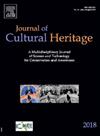Integrated analytical techniques for the study of composite waterproof caulking materials used on the Nanhai Ⅰ ancient shipwreck of the Southern Song Dynasty
IF 3.5
2区 综合性期刊
0 ARCHAEOLOGY
引用次数: 0
Abstract
“Nianliao” is an organic-inorganic composite material historically employed in ancient Chinese wooden ship construction for gap filling and waterproofing. This study examines two types of Nianliao samples from the Nanhai I shipwreck of the Southern Song Dynasty (1127–1279 CE): fiber-containing Nianliao and pure putty Nianliao. The objective of this research is to develop a systematic analytical method for this ancient composite material, thereby uncovering the production techniques and characteristics of historical Chinese waterproofing caulking materials. To analyze the organic components of Nianliao, we introduced a novel and rapid method utilizing ultra-high-performance supercritical fluid chromatography coupled with quadrupole time-of-flight mass spectrometry (UHPSFC-QTOF/MS). This approach facilitates the direct analysis of fatty acids in Nianliao samples without derivatization, successfully isolating and identifying various free fatty acids and their oxidation products. Based on these findings, we infer that tung oil constitutes the organic component of the Nianliao samples. Additionally, the study elucidates the composition, aging characteristics, and interactions of Nianliao components through complementary instrumental analytical techniques. Inorganic compounds were characterized using Fourier-transform infrared spectroscopy (FTIR), X-ray diffraction (XRD), and scanning electron microscopy-energy dispersive X-ray spectroscopy (SEM-EDS). These analyses revealed that the primary inorganic component was calcium carbonate, formed through lime carbonation. Calcium salts of fatty acids were also detected, indicating a reaction between tung oil and lime that facilitated the integration of organic and inorganic components. Fibers present in some samples were analyzed based on their longitudinal and transverse morphological characteristics and identified as hemp fibers. Furthermore, differential scanning calorimetry-thermogravimetry (DSC-TG) was employed for quantitative analysis. This analysis revealed significant differences in organic content between the two types of Nianliao samples, which influenced their microstructural properties. Specifically, the fiber-containing Nianliao samples exhibited a denser microstructure and contained approximately four times more tung oil compared to the pure putty Nianliao samples. This research provides novel insights and methodologies for analyzing organic compounds in archaeological contexts. It establishes a scientific foundation for the restoration and archaeological study of ancient wooden shipwrecks and contributes to the development of effective conservation strategies.

南海Ⅰ南宋古沉船复合防水填缝材料综合分析技术研究
“年料”是一种有机-无机复合材料,历史上用于中国古代木船的空隙填充和防水。本研究对南宋南海一号海难出土的两种类型的念辽样品进行了研究:含纤维念辽和纯腻子念辽。本研究的目的是对这种古老的复合材料建立系统的分析方法,从而揭示中国历史防水填缝材料的生产技术和特点。为了分析年料的有机成分,我们建立了一种新的、快速的方法——超高效超临界流体色谱-四极杆飞行时间质谱联用(UHPSFC-QTOF/MS)。该方法方便了年料样品中脂肪酸的直接分析,无需衍生化,成功分离鉴定了多种游离脂肪酸及其氧化产物。根据这些发现,我们推断年辽样品的有机成分为桐油。此外,本研究还通过互补的仪器分析技术阐明了年料成分的组成、老化特征和相互作用。采用傅里叶变换红外光谱(FTIR)、x射线衍射(XRD)和扫描电镜-能量色散x射线能谱(SEM-EDS)对无机化合物进行了表征。这些分析表明,主要的无机成分是碳酸钙,由石灰碳化形成。脂肪酸的钙盐也被检测到,表明桐油和石灰之间的反应促进了有机和无机成分的整合。对部分样品的纤维进行了纵向和横向形态特征分析,鉴定为大麻纤维。采用差示扫描量热-热重法(DSC-TG)进行定量分析。分析结果表明,两类年辽样品的有机含量存在显著差异,影响了其微观结构特性。具体来说,含纤维的年料样品显示出更致密的微观结构,与纯腻子年料样品相比,其桐油含量约为四倍。这项研究为在考古背景下分析有机化合物提供了新的见解和方法。它为古代木船残骸的修复和考古研究奠定了科学基础,并有助于制定有效的保护策略。
本文章由计算机程序翻译,如有差异,请以英文原文为准。
求助全文
约1分钟内获得全文
求助全文
来源期刊

Journal of Cultural Heritage
综合性期刊-材料科学:综合
CiteScore
6.80
自引率
9.70%
发文量
166
审稿时长
52 days
期刊介绍:
The Journal of Cultural Heritage publishes original papers which comprise previously unpublished data and present innovative methods concerning all aspects of science and technology of cultural heritage as well as interpretation and theoretical issues related to preservation.
 求助内容:
求助内容: 应助结果提醒方式:
应助结果提醒方式:


